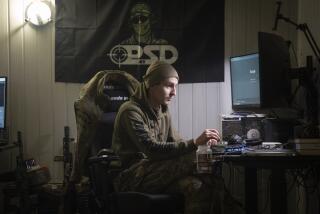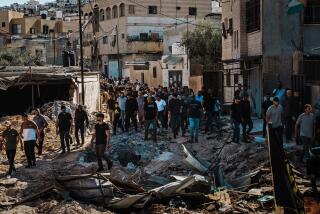Communications Gone, Iraqis Maneuvered in the Dark
- Share via
RIYADH, Saudi Arabia — The morning fog coated the desert plains of southern Kuwait, and the U.S. Marine’s 2nd Division was poised to march toward Kuwait city.
Their left flank exposed, they awaited Saddam Hussein’s counterattack.
And they waited.
Six hours passed on that second day of the ground war before the Iraqi army finally launched insignificant, misplaced counterpunches.
“It was at that point,” a senior American intelligence officer said, “that we knew we had him.”
With relentless air strikes in the weeks leading up to last week’s Gulf War ground campaign, coalition forces had targeted the network used by Iraqi field commanders to communicate with their top leadership and with each other, the network for sending and receiving combat orders.
It was the success in destroying that “command and control” structure, from radio transmitters to fiber-optic lines, that gave the U.S.-led coalition a crucial advantage.
Unable to communicate, Iraqi commanders could not follow their enemy’s movements and, just as important, could not react promptly once they caught on. It became impossible to coordinate counterattacks.
Throughout the 100-hour blitz, there were signs of disarray that come when communications fail: Iraqi tanks frequently were reported going the wrong way. Iraqi battalions, fighting for their lives, rarely received backup. There were few coordinated attacks by the Iraqis.
“The left didn’t know what the right was doing, nor the center,” Marine Brig. Gen. Richard I. Neal said.
Even now, the breakdown in communications remains evident: isolated bands of Iraqi soldiers wander through northern Kuwait and southern Iraq, unaware that the war was suspended Wednesday and a formal cease-fire is in the works. And the withdrawal that Saddam Hussein ordered on Radio Baghdad proceeded with haphazard irregularity.
Allied forces patrolling the desert are broadcasting Arabic-language messages on loudspeakers to spread the news to Iraqi troops that they should lay down their weapons and go home.
In the early days of the war, American bombers went after components of Iraq’s military communications network. Radio towers and microwave repeaters were blown up; many of Hussein’s more secure ground lines were destroyed when air strikes targeted the bridges that took the lines over waterways.
The Iraqis found ways around the destruction. Mysterious coded messages were heard going out over Radio Baghdad. And, throughout much of the war, allied intelligence detected microwave and multi-channel communication stations popping up in different spots all over the countryside, used by commanders to talk to their troops.
But even those mobile units disappeared a day before the cease-fire, a senior military source said.
“What little was left, absolutely disappeared,” he said. “It just went into total chaos, and that contributed in no small measure . . . to the success, the speed by which we were able to effect this operation.”
The attack on the command and control structure paid off for the allies time and again. But it was the push into Kuwait by the Marines’ 2nd Division that some top American officers view as the moment that dispelled any doubts.
Day Two of the ground war, and the Marines had pushed easily about 40 miles northward into Kuwait and were gearing to turn east toward Kuwait city, their objective.
Daylight had not yet illuminated the battlefield; surely, the men thought, Hussein’s tank guns would soon use the cover of the dawn fog to train on their positions.
It would not happen. Six hours passed, noon came, and only then did small battalion-sized segments of Iraq’s 3rd Armored Division and 5th Mechanized Division begin counterattacking. And in the wrong place, at that.
Instead of hitting the Marines’ exposed western flank, the Iraqis ran head-on into the northern-most Marine positions.
At that point, the intelligence officer said, “we knew his command and control structure was shot. . . . It was clear that anything he did would be piecemeal from that time on. We knew he wouldn’t be able to get it together.”
Similar scenes were repeated elsewhere in the war theater.
The British 1st Armored Division had traveled west along the Saudi border, then turned north into Iraq. By the time the Tawakalna and Medina Republican Guard divisions became aware of the British movement, it was too late, British officers say. The Republican Guard was being overrun by British tanks.
Nearby, the U.S. 1st Cavalry made a similar push into Iraq.
“I just do not understand how he did not know we were coming,” Lt. Col. Vollney Corn said after leading 100,000 troops 250 miles in three days.
To hear Iraqi prisoners of war tell it, they were simply in the dark.
“Prisoners said they weren’t afraid to fight us,” said Brig. Gen. Ron Griffith of the U.S. 1st Army Division. “They just couldn’t find us.”
This report was based in part on pool dispatches.
More to Read
Sign up for Essential California
The most important California stories and recommendations in your inbox every morning.
You may occasionally receive promotional content from the Los Angeles Times.














